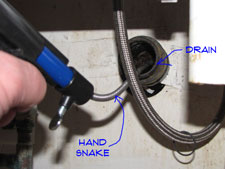 Snaking a kitchen sink is more work and makes a bigger mess than some of the other options. Kitchen sinks tend to have a lot of grease going down the drain. This makes them resistant to being cleaned out easily. Sometimes a snake is the only thing that will work.
Snaking a kitchen sink is more work and makes a bigger mess than some of the other options. Kitchen sinks tend to have a lot of grease going down the drain. This makes them resistant to being cleaned out easily. Sometimes a snake is the only thing that will work.
For related information see, 'How To Snake a Drain', 'Kitchen Sink Plumbing' and 'How To Clean a Drain'.
Removing Plumbing Pipes
A kitchen sink normally drains through an 1 1/2" pipe that is connected to your homes sewer pipes. Thes pipes drain out into a sewer or septic system.
To use a snake you need to disconnect the trap assemply pipes from the drain inlet. The drain inlet will be located on the wall behind the sink or on the floor below it. Use adjustable pliers or a pipe wrench to remove the fittings.
See the article on 'Sink Drain Plumbing' for information on what parts you may need to replace. This article also provides information on how to tighten the pipes properly.
Using a Hand Snake
Some of them have a crank or they may just have a movable handle the allows you to turn the snake. Usually you will not need an electric snake for a sink drain. Unless you have one that attaches to a drill. Use that if you have it.
You want to run the snake in at the wall. Use the adjustable pliers and take off the nut for the outlet the goes into the wall.
You will have to turn it and apply pressure to get it to go around the bends in the pipes. Twenty five feet is usually plenty for a sink drain. On a rare occasion you will have to go farther. You should get some resistance when you get to the clog. If the pipe still has water in it you should be able to hear it when the clog breaks free.
Run the snake back and forth until it moves freely. Pull the snake out being careful not to get the dirty water everywhere. Put the drains back together and try the sink. Success? The water goes down? Wonderful, this clogged kitchen sink drain is now just a bad memory.
Using an Electric Snake
A small snake that will attach to an electric drill will also work on a kitchen snake. The procedure is similar to a hand snake. One difference is that you want to keep the snake housing close to the inlet for the drain. Too much slack on the snake may allow it to twist and tangle when it hits an obstruction.
Use gentle pressure on the snake to get it to go around bends in the pipe and past obstructions.
An electric snake turns faster than a hand snake, so dirty water splattering everywhere is a problem. Try to cover as much of the area as you can.
Determining Success
A major drawback to using a snake on a kitchen sink line is that it is difficult to tell when the drain has opened up. This is especially true if the snake is going through grease. If you can get a hose to the drain inlet, you can try running water down the drain. Warm water is the best, but cold will work. Be careful and be ready to shut the water off quickly if the drain has not opened up.
If you cannot run water down the drain, you will need to put the trap back together in order to test the sink. Assemble the trap and try running water down the drain. If it goes down you are sucessful. Run hot water down the drain for a while to help wash away the grease and residue.